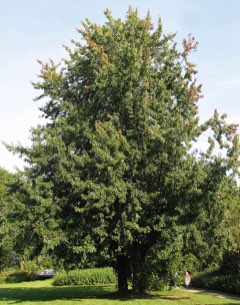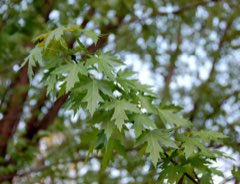 |
|
wikimedia.org |
 |
| © Derek Ramsey / derekramsey.com |
Translate this page:
Summary
Sometimes misspelt as Acer saccharinium. Bloom Color: Red.
Main Bloom Time: Early spring, Late spring, Mid spring. Form: Vase.
Physical Characteristics

 Acer_saccharinum is a deciduous Tree growing to 30 m (98ft) by 15 m (49ft) at a fast rate.
Acer_saccharinum is a deciduous Tree growing to 30 m (98ft) by 15 m (49ft) at a fast rate.
See above for USDA hardiness. It is hardy to UK zone 3. It is in flower from February to March, and the seeds ripen from April to June. The species is hermaphrodite (has both male and female organs) and is pollinated by Wind.
Suitable for: light (sandy), medium (loamy) and heavy (clay) soils and can grow in heavy clay soil. Suitable pH: mildly acid, neutral and basic (mildly alkaline) soils. It can grow in semi-shade (light woodland) or no shade. It prefers moist soil. The plant can tolerates strong winds but not maritime exposure.
It can tolerate atmospheric pollution.
UK Hardiness Map
US Hardiness Map
Synonyms
A. dasycarpum. A. eriocarpum.
Plant Habitats
Edible Uses
The sap contains sugar and can be used as a drink or be concentrated into a syrup by boiling off the water[4, 61, 82, 159]. The syrup is used as a sweetener on many foods. The yield is only half that of A. saccharum[2]. It is said to be sweeter and whiter than A. saccharum[183]. The sap can be harvested in the late winter, the flow is best on warm sunny days following a frost. The best sap production comes from cold-winter areas with continental climates. Self-sown seedlings, gathered in early spring, are eaten fresh or dried for later use[177, 213]. Seeds - cooked. The wings are removed and the seeds boiled then eaten hot[213]. Good crops are produced nearly every year in the wild[229]. The seed is about 12mm long and is produced in small clusters[82]. Inner bark - cooked. It is dried, ground into a powder and then used as a thickening in soups etc or mixed with cereals when making bread[105, 161, 177, 257]. The related Oregon Maple (Acer macrophyllum) has yellow flower clusters, sweet with nectar, eaten raw[183]. No information was found for this species. Carbon farming - Staple Crop: sugar.
References More on Edible Uses
Medicinal Uses
Plants For A Future can not take any responsibility for any adverse effects from the use of plants. Always seek advice from a professional before using a plant medicinally.
An infusion of the bark is used in the treatment of coughs, cramps and dysentery[257]. The infusion is also applied externally to old, stubborn running sores[257]. A compound infusion is used in the treatment of 'female complaints'[257]. The inner bark is boiled and used with water as a wash for sore eyes[257]. An infusion is used internally in the treatment of diarrhoea[257]. An infusion of the root bark has been used in the treatment of gonorrhoea[257].
References More on Medicinal Uses
The Bookshop: Edible Plant Books
Our Latest books on Perennial Plants For Food Forests and Permaculture Gardens in paperback or digital formats.

Edible Tropical Plants
Food Forest Plants for Hotter Conditions: 250+ Plants For Tropical Food Forests & Permaculture Gardens.
More

Edible Temperate Plants
Plants for Your Food Forest: 500 Plants for Temperate Food Forests & Permaculture Gardens.
More

More Books
PFAF have eight books available in paperback and digital formats. Browse the shop for more information.
Shop Now
Other Uses
The leaves are packed around apples, rootcrops etc to help preserve them[18, 20]. A fairly wind-tolerant tree, it can be used in shelterbelt plantings[200]. The branches are rather brittle, however, and can break off even in minor storms[226]. The stems are used in making baskets[257]. The boiled inner bark yields a brown dye[106]. Mixed with lead sulphate this produces a blue/black dye which can also be used as an ink[106]. A black dye is obtained from the twigs and bark[257]. The bark can be boiled, along with hemlock (Tsuga spp]) and swamp oak bark (Quercus bicolor) to make a wash to remove rust from iron and steel, and to prevent further rusting[257]. Wood - rather brittle, close-grained, hard, strong, easily worked but not durable. It weighs 32lb per cubic metre. It has many uses such as veneer, cooperage, furniture, flooring and pulp[11, 46, 82, 227, 235]. Carbon Farming - Industrial Crop: biomass. Agroforestry Services: crop shade. Fodder: bank. A dynamic accumulator gathering minerals or nutrients from the soil and storing them in a more bioavailable form - used as fertilizer or to improve mulch.
Special Uses
References More on Other Uses
Cultivation details
Landscape Uses:Erosion control, Firewood, Aggressive surface roots possible, Woodland garden. Of easy cultivation, it prefers a good moist well-drained soil[1, 11] but does well in much wetter soils than most member of the genus. Succeeds in most soils including chalk[98]. Another report says that this species is liable to become chlorotic as a result of iron deficiency when it is grown on alkaline soils. Grows well in heavy clay soils. Prefers a moderately sunny position[11, 200]. Tolerates atmospheric pollution[200]. Fairly wind-tolerant[200]. The wood is brittle and branches are liable to break off the tree in high winds[11, 200]. Trees can tolerate short periods of flooding, but are very susceptible to fire[229]. A very ornamental[1] and fast growing tree[11, 98], but it is short-lived[227], seldom surviving longer than 125 - 140 years[229]. The tree has invasive roots and these often interfere with sewer pipes and drainage tiles around houses[226]. The silver maple is a bad companion plant, inhibiting the growth of nearby plants[18, 20]. Special Features:Attracts birds, North American native, Naturalizing. Carbon farming - Cultivation: experimental. Management: standard, coppice. The plant is heat tolerant in zones 8 through 1. (Plant Hardiness Zones show how well plants withstand cold winter temperatures.
Plant Heat Zones show when plants would start suffering from the heat.
The Plant Heat Zone map is based on the number of "heat days" experienced in a given area where the temperature climbs to over 86 degrees F (30°C).
At this temperature, many plants begin to suffer physiological damage. Heat Zones range from 1 (no heat days) to 12 (210 or more heat days).
For example Heat Zone. 11-1 indicates that the plant is heat tolerant in zones 11 through 1.) For polyculture design as well as the above-ground architecture (form - tree, shrub etc. and size shown above) information on the habit and root pattern is also useful and given here if available. The plant growth habit is a standard with a non-suckering single trunk [1-2]. The root pattern is flat with shallow roots forming a plate near the soil surface [1-2].
References Carbon Farming Information and Carbon Sequestration Information
Temperature Converter
Type a value in the Celsius field to convert the value to Fahrenheit:
Fahrenheit:
The PFAF Bookshop
Plants For A Future have a number of books available in paperback and digital form. Book titles include Edible Plants, Edible Perennials, Edible Trees,Edible Shrubs, Woodland Gardening, and Temperate Food Forest Plants. Our new book is Food Forest Plants For Hotter Conditions (Tropical and Sub-Tropical).
Shop Now
Plant Propagation
Seed - best sown as soon as it is ripe in the spring in a cold frame. It usually germinates immediately and by the end of summer has formed a small tree with several pairs of leaves[82]. Stored seed quickly loses its viability. Pre-soak stored seed for 24 hours and then stratify for 2 - 4 months at 1 - 8°c. It can be slow to germinate. When large enough to handle, prick the seedlings out into individual pots and grow them on until they are 20cm or more tall before planting them out in their permanent positions. Layering, which takes about 12 months, is successful with most species in this genus. Cuttings of young shoots in June or July. The cuttings should have 2 - 3 pairs of leaves, plus one pair of buds at the base. Remove a very thin slice of bark at the base of the cutting, rooting is improved if a rooting hormone is used. The rooted cuttings must show new growth during the summer before being potted up otherwise they are unlikely to survive the winter.
Other Names
If available other names are mentioned here
Native Plant Search
Search over 900 plants ideal for food forests and permaculture gardens. Filter to search native plants to your area. The plants selected are the plants in our book 'Plants For Your Food Forest: 500 Plants for Temperate Food Forests and Permaculture Gardens, as well as plants chosen for our forthcoming related books for Tropical/Hot Wet Climates and Mediterranean/Hot Dry Climates. Native Plant Search
Found In
Countries where the plant has been found are listed here if the information is available
Weed Potential
Right plant wrong place. We are currently updating this section.
Please note that a plant may be invasive in one area but may not in your area so it’s worth checking.
No
Conservation Status
IUCN Red List of Threatened Plants Status : This taxon has not yet been assessed

Growth: S = slow M = medium F = fast. Soil: L = light (sandy) M = medium H = heavy (clay). pH: A = acid N = neutral B = basic (alkaline). Shade: F = full shade S = semi-shade N = no shade. Moisture: D = dry M = Moist We = wet Wa = water.

Expert comment
Author
L.
Botanical References
1143200
Links / References
For a list of references used on this page please go here
Readers comment
© 2010, Plants For A Future. Plants For A Future is a charitable company limited by guarantee, registered in England and Wales. Charity No. 1057719, Company No. 3204567.